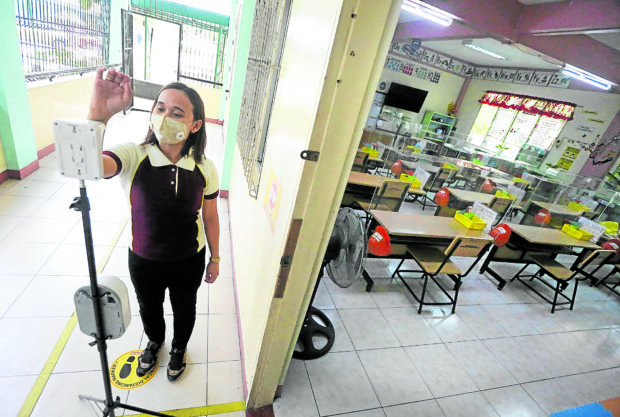
(FILE PHOTO) On October 19, 2021, a grade school teacher of Aurora Quezon Elementary school in Manila demonstrate what a face-to-face class would look like amid the COVID-19 pandemic, with plastic barriers separating each armchair from one another and teachers wearing PPE during class. INQUIRER/MARIANNE BERMUDEZ
MANILA, Philippines — The country’s chief economist has urged the Department of Education (DepEd) to facilitate make-up classes for younger school children as well as training for college students to make up for the two years of subpar learning due to the prolonged COVID-19 pandemic.
Socioeconomic Planning Secretary Arsenio Balisacan last week said “a learning catch-up plan is crucial [to] help secure better opportunities for future generations and ensure that our demographic dividend will not be wasted.”
Here in the Philippines, students had been mostly attending online classes, which experts believed weren’t at par with in-person schooling, these past two years. The administration of President Ferdinand Marcos Jr. plans to revert to 100-percent face-to-face classes by November of the incoming school year.
Moving forward, learning should be augmented outside the classroom among primary or elementary pupils and secondary or high school students, Balisacan told reporters.
“It could be training, additional work that needs to be done for the kids,” especially in basic math, the Neda chief said, citing that the last two years of subpar education would result in human capital losses.
Balisacan said younger school children, in particular, were “too far behind” in their learning requirements, hence they should be focused on when they go back to face-to-face classes.
For tertiary or college students, catch-up training and internships should be made available, Balisacan said.
Asked if learning catch-up would entail longer school days or shorter breaks, Balisacan replied: “Why not?” and added that educational institutions “will have to be imaginative.”
Earlier estimates of the state planning agency National Economic and Development Authority (Neda), which Balisacan heads, showed that for every school year that students did not attend face-to-face classes, a total of P11 trillion in productivity losses would be inflicted during a 40-year period spanning a person’s working life.
The joint report “The State of Global Learning Poverty: 2022 Update” report jointly published by the World Bank, the United Nations Educational, Scientific and Cultural Organization (Unesco), UN Children’s Fund (Unicef), the UK government’s Foreign Commonwealth and Development Office, USAID, as well as the Bill and Melinda Gates Foundation last month recommended a so-called “Rapid” framework to “help children recover lost learning, and to accelerate long-term progress in foundational learning.”
The acronym Rapid meant educators should: Reach every child and keep them in school; Assess learning levels regularly; Prioritize teaching the fundamentals; Increase the efficiency of instruction, including through catch-up learning; and Develop psychosocial health and well-being.
Citing previously reported estimates for 2019, learning poverty in the Philippines pre-pandemic already stood at 90.9 percent, while learning deprivation, defined by the report as “the share of children at the end of primary (elementary) who read below the minimum proficiency level,” was also a high of 90.4 percent three years ago.
Schooling deprivation or “the share of primary-aged children who are out of school,” hence “assumed to be below the minimum proficiency level in reading” in the Philippines in 2019 was 5 percent, World Bank estimates based on the country’s performance in the 2019 Southeast Asia Primary Learning Metrics (SEA-PLM) showed.
It did not help that a blog of the Tokyo-based think tank Asian Development Bank Institute (ADBI) last week cited a recent report showing that “in terms of training non-affordability, the Philippines ranked highest among Asean countries, with over one in three youth responding that their lack of training was due to training opportunities being expensive.”
“In the Philippines, a lack of financial capacity or the high cost of training is the most widely-cited challenge to attending training among young people (36.1 percent). In connection to this, respondents also mentioned that incidental expenses such as the need to purchase materials or software (such as Microsoft Office, STATA, and SPSS) prohibit them from pursuing skills training programs,” according to the joint report of Asean Foundation, Plan International, and Google titled “Mind the Gap: Mapping Youth Skills for the Future in Asean” published last month.
“Youth NEET [not in education, employment or training] cite financial constraints as the main barrier to employment. The low uptake of training programs among the youth puts them at a disadvantage as they do not acquire new skills to adapt to the job market,” the report said.